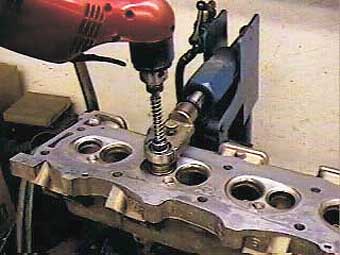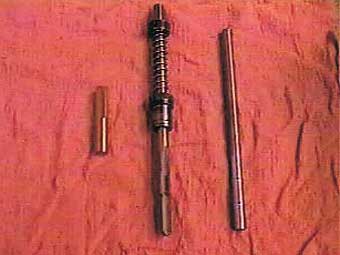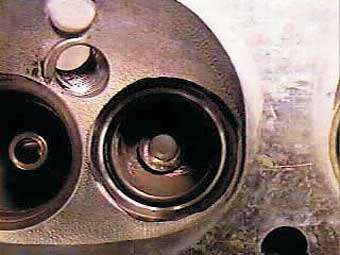
Rover head set up in the K-Line valve guide boring machine.
Rover Valve Guide Options
This article appeared in The British V8 Newsletter - Volume XII, Issue 1 - January 2004by: Dale Spooner
Time to get those Rover heads reconditioned? An essential part of any valve job is to replace worn guides and there is an option to replacing the OE guides that you may not be aware of. And for several reasons it is a much more desirable alternative. This is certainly not a new process but one that definitely results in a better product, particularly on Rover heads. Most multivalve foreign heads and, oddly enough, Rover, employ manufacturing techniques that make guide replacement an adventure for automotive machinists, me being one of them.
When the heads are produced, the guides are installed in the heads with an unfinished ID.
The guide is then finish bored or reamed in the heads and the valve seat is cut in one
machining operation. The problem with this process is that you now have a valve guide with
an ID that is not necessarily on the same centerline as the OD. This matters not until the
day some poor unsuspecting machinist drives out the old guides and replaces them with
concentric finished ID guides. When he comes to machine the valve seats he discover that the
guide/seat alignment has been drastically affected. His only choice now is to sink the seats
until they clean up (highly undesirable) or machine for oversize seats and start over (highly
expensive). All heads that are produced with this method experience this problem when the
guides are replaced. The fix for this is to leave the OE guides in place and reline them
with a thin wall bronze liner. Besides giving the benefit of a better bearing surface for
the valve, the valve seat alignment is unaffected because the liner is installed using the
valve seat and the original guide ID of the guide as a centering reference. This is realized
only if the heads are done on equipment designed for this purpose.
The company that has the best setup for this is K-Line and their system works very well. Photo 1 shows a Rover head set up in their fixture. A bronze liner, a boring/reaming tool and a sizing broach are shown in Photo 2.
After a seat centering adapter is air clamped in the fixture the boring/reaming tool is run through the guide, machining it to 0.030" oversize so as to accept the liner. The liner is then installed and the appropriate sizing broach is driven through the liner, burnishing the guide ID and bringing it close to finish size. A valve guide bore gauge (Photo 3) should be used to measure the actual valve stem clearance. I always finish guide ID's with a Sunnen guide hone (Photo 4). Leaving 0.0005" of material to hone gives a perfectly round and straight hole with a superior finish. Now that the guides have been renewed by this method the seat alignment has not changed and machining the seats will result in minimal material removal.
Photo 5 shows a seat touched by just a 45 degree stone (shiny area) and you can see how the valve
seat location did not change. By not lowering the seat depths the valves remain unshrouded, no
loss of spring installed height and no negative effect on rocker geometry. I do machine work for
the local Rover dealer and was replacing many valve guides and valves supplied by them. They were
experiencing a valve seizing problem, even on low mileage cars. The OE replacement guides that were
being sent were 0.030" under on the ID. This was my first clue that the heads were produced using
the aforementioned method.
I did a couple sets of heads with their parts but then after considerable protest by me I convinced the rep to let me reline them instead to save them money and to save me time and frustration. I am not a Rover/Buick/Olds expert by any stretch so I do not know which heads are affected by this new process of manufacture. I suspect it is mostly late model Rovers and not any GM heads.
The company that has the best setup for this is K-Line and their system works very well. Photo 1 shows a Rover head set up in their fixture. A bronze liner, a boring/reaming tool and a sizing broach are shown in Photo 2.
|
Enjoying this article? Our magazine is funded through the generous support of readers like you! To contribute to our operating budget, please click here and follow the instructions. (Suggested contribution is twenty bucks per year. Feel free to give more!) |
After a seat centering adapter is air clamped in the fixture the boring/reaming tool is run through the guide, machining it to 0.030" oversize so as to accept the liner. The liner is then installed and the appropriate sizing broach is driven through the liner, burnishing the guide ID and bringing it close to finish size. A valve guide bore gauge (Photo 3) should be used to measure the actual valve stem clearance. I always finish guide ID's with a Sunnen guide hone (Photo 4). Leaving 0.0005" of material to hone gives a perfectly round and straight hole with a superior finish. Now that the guides have been renewed by this method the seat alignment has not changed and machining the seats will result in minimal material removal.
 K-Line boring/reaming tool, sizing broach, shown alongside a bronze liner. |
 Measuring valve guide/valve stem clearance using a valve guide bore gauge. |
|
 Finishing the valve guide ID using a Sunnen valve guide hone. |
 This valve seat has been just touched with a 45 degree stone. The shiny area shows that the seat hasn't changed. |
I did a couple sets of heads with their parts but then after considerable protest by me I convinced the rep to let me reline them instead to save them money and to save me time and frustration. I am not a Rover/Buick/Olds expert by any stretch so I do not know which heads are affected by this new process of manufacture. I suspect it is mostly late model Rovers and not any GM heads.
On a related topic, Rover also had problems in the mid '90's with valve seals losing their press fit
on the guides and coming off, allowing excess oil down the guides. Once again my local Rover dealer
would send me heads with all new replacement guides to remedy the problem. Obviously I was motivated
to not change any guides if at all possible, so after a little research I discovered that the problem
was actually that the diameter of the guide where the seal goes was machined too big, not too small
as they suspected. The Rover spec is .495", the defective guides averaged about .510", providing too
much press fit and distorting the seals on installation.
After some more research I found that the seal Rover uses is the exact seal that Comp Cams also sells (a German seal, go figure). However Comp calls for a guide diameter of 0.485", not 0.495". The easy fix on these heads is to leave the defective guides in the heads and cut them with Comps 0.485" cutter, again saving me time and Rover warranty money. This seal problem was limited to a small number of heads (I did 4 sets I think) so it is unlikely that most people would ever see it, but I thought it worth mentioning.
After some more research I found that the seal Rover uses is the exact seal that Comp Cams also sells (a German seal, go figure). However Comp calls for a guide diameter of 0.485", not 0.495". The easy fix on these heads is to leave the defective guides in the heads and cut them with Comps 0.485" cutter, again saving me time and Rover warranty money. This seal problem was limited to a small number of heads (I did 4 sets I think) so it is unlikely that most people would ever see it, but I thought it worth mentioning.
So when the time comes to freshen your heads talk to your local shops and find one that understands
the problem and has the right equipment to do the job. Like I always say sometimes, do it right or
do it twice, do it right or do it right-away, and tight ain't right.
Disclaimer: This page was researched and written by Dale Spooner. Views expressed are those of the author, and are provided without warrantee or guarantee. Apply at your own risk.
Disclaimer: This page was researched and written by Dale Spooner. Views expressed are those of the author, and are provided without warrantee or guarantee. Apply at your own risk.

